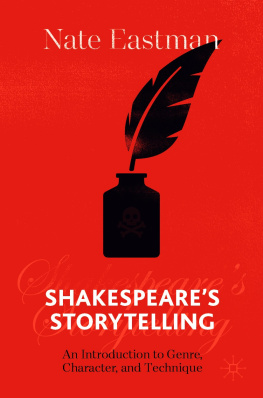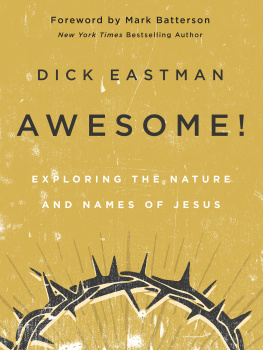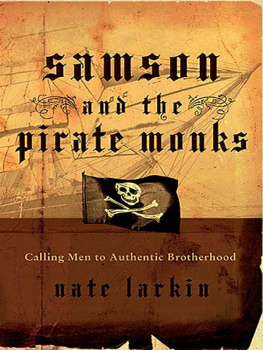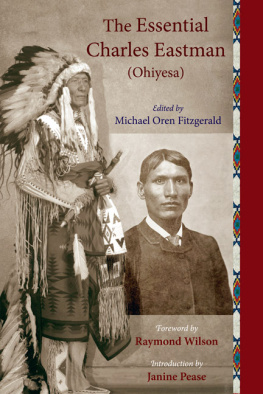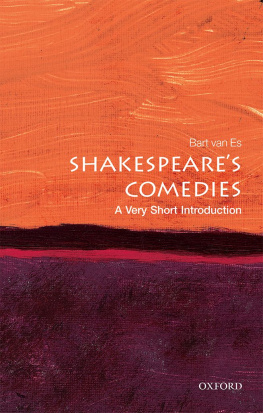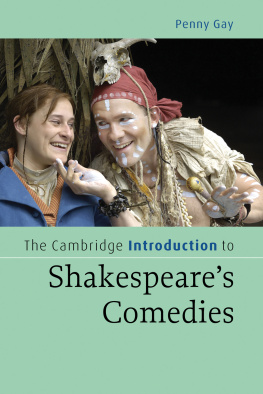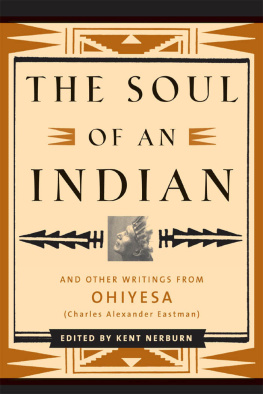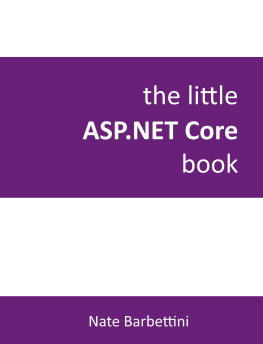Nate Eastman - Shakespeares Storytelling: An Introduction to Genre, Character, and Technique
Here you can read online Nate Eastman - Shakespeares Storytelling: An Introduction to Genre, Character, and Technique full text of the book (entire story) in english for free. Download pdf and epub, get meaning, cover and reviews about this ebook. year: 2021, publisher: Springer International Publishing, genre: Art. Description of the work, (preface) as well as reviews are available. Best literature library LitArk.com created for fans of good reading and offers a wide selection of genres:
Romance novel
Science fiction
Adventure
Detective
Science
History
Home and family
Prose
Art
Politics
Computer
Non-fiction
Religion
Business
Children
Humor
Choose a favorite category and find really read worthwhile books. Enjoy immersion in the world of imagination, feel the emotions of the characters or learn something new for yourself, make an fascinating discovery.
- Book:Shakespeares Storytelling: An Introduction to Genre, Character, and Technique
- Author:
- Publisher:Springer International Publishing
- Genre:
- Year:2021
- Rating:3 / 5
- Favourites:Add to favourites
- Your mark:
- 60
- 1
- 2
- 3
- 4
- 5
Shakespeares Storytelling: An Introduction to Genre, Character, and Technique: summary, description and annotation
We offer to read an annotation, description, summary or preface (depends on what the author of the book "Shakespeares Storytelling: An Introduction to Genre, Character, and Technique" wrote himself). If you haven't found the necessary information about the book — write in the comments, we will try to find it.
Nate Eastman: author's other books
Who wrote Shakespeares Storytelling: An Introduction to Genre, Character, and Technique? Find out the surname, the name of the author of the book and a list of all author's works by series.
Shakespeares Storytelling: An Introduction to Genre, Character, and Technique — read online for free the complete book (whole text) full work
Below is the text of the book, divided by pages. System saving the place of the last page read, allows you to conveniently read the book "Shakespeares Storytelling: An Introduction to Genre, Character, and Technique" online for free, without having to search again every time where you left off. Put a bookmark, and you can go to the page where you finished reading at any time.
Font size:
Interval:
Bookmark:
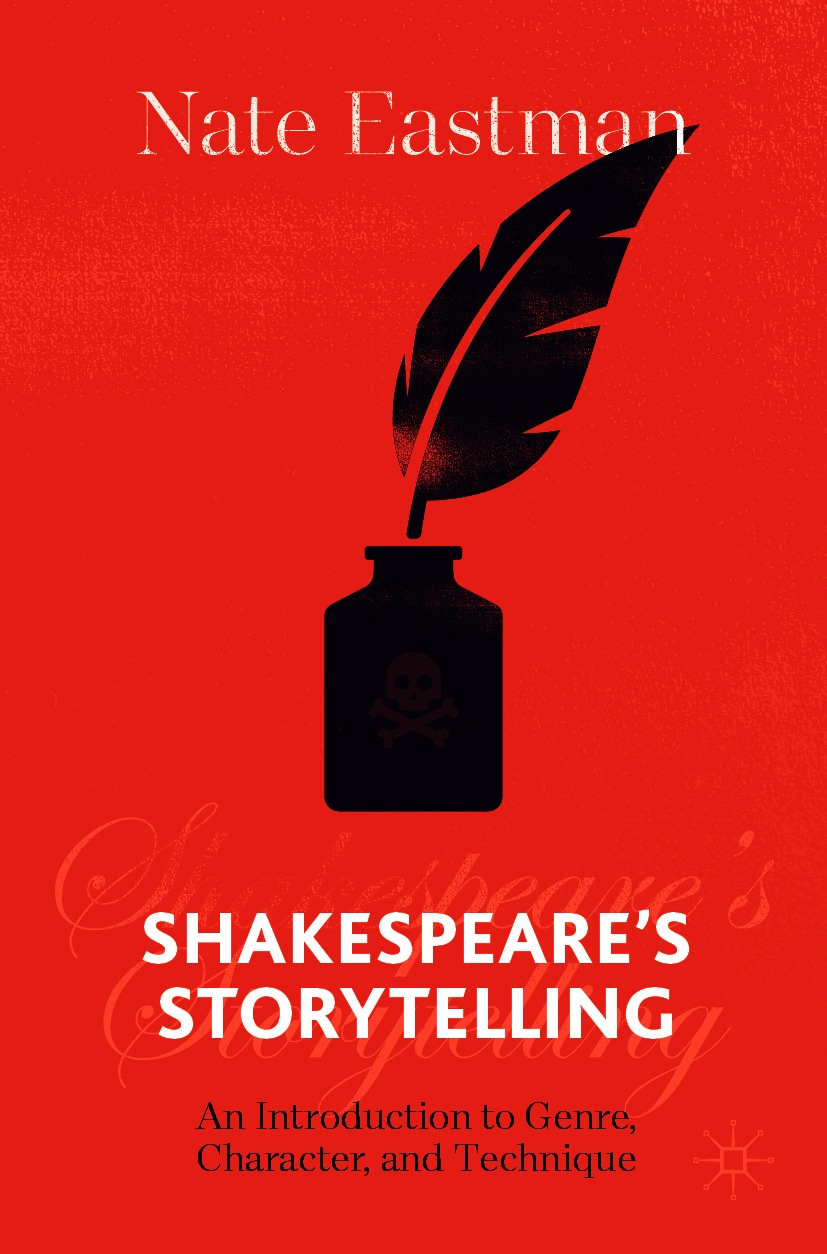

Cover design by Isaac
This Palgrave Macmillan imprint is published by the registered company Springer Nature Switzerland AG
The registered company address is: Gewerbestrasse 11, 6330 Cham, Switzerland
Aspiring professional Shakespeareans need to learn all kinds of things before they go to graduate school: the differences between fair and foul copies, between quartos and folios, and between the typesetting habits of A and B compositors. They need to read Norths translations of Plutarchs Lives, and Holinsheds Chronicles, and histories from Conrad Russell and Christopher Hill. They need to know what influential Shakespeare criticsfrom Samuel Taylor Coleridge and Samuel Johnson to Jean Howard and Margarita de Graziahave had to say about Hamlet . And so most undergraduate Shakespeare courses focus on these topics.
This is wonderful for aspiring professional Shakespeareans, who see clear connections between what they learn in Shakespeare, what they think is important, and what theyll do in the future. But in my sections of Shakespeare, every aspiring Shakespeare professor enrolls in the company of about fifty aspiring software developers. That one Shakespearean is also in the company of about fifty aspiring doctors, accountants, and engineers. The world might need Shakespeare professors, but it doesnt need that many of them.
I wrote this book because every studentnot just the aspiring Shakespeare professordeserves a Shakespeare course that speaks to their interests, that helps them make sense of Shakespeares plays, and that helps them discover why Shakespeare is worthwhile. And so this book is about Shakespeares storytelling .
A story is any relation of events in which a character tries to get something they want. As a genre, it includes most novels, movies, comic books, and television shows. Unless you have a shriveled-up turd for a heart, you know and love at least one story. Maybe you read Harry Potter and the Sorcerers Stone (1999) as a child (or still read it as an adult) or keep up with Hugo winners like N. K. Jemisins The Fifth Season (2015). Maybe you watch Disney movies. Maybe you dig on sprawling, multiple-narrative pieces of storytelling like George R. R. Martins A Game of Thrones (1996), or Stephen Kings IT (1986), or multi-generational pieces of storytelling like Amy Tans The Joy Luck Club (1989) or Gabriel Garcia Marquezs One Hundred Years of Solitude (1967).
Stories bring us joy. They prompt us to reflect on the hows and whys of life, and to develop the kind of emotional intelligence that used to be called wisdom. Unless you are seriously unlucky, you will read, or see, at least one more story before the universe packs you up for recycling. This book will help you understand how that story does what it does, and why that story has Shakespeares fingerprints all over it.
Shakespeare defined the modern story and invented what are now indispensable storytelling techniques. We talk about Shakespeare in the same ways that programmers talk about Grace Hopper (who invented the compiler), the way that science fiction writers talk about N. K. Jemisin (who won three Best Novel Hugo Awards in a row), or the way that directors talk about Steven Spielberg (who invented the Summer blockbuster). These are players who, like Shakespeare, gamed so well that they changed the rules.
This book will help you better understand storytelling : what storytellers do, and which techniques they use to do it. This is important because you might have already learned other concepts that allegedly help you understand how stories are put together concepts like rising action, climax, or protagonistand, well, you might as well try to understand a story by throwing rocks at it. Who is the protagonist in A Midsummer Nights Dream? Which scene is the climax? What does applying these labels to the play, or to its characters, teach you about how they work? Luckily, this book will help you learn to use a better set of tools.
This book will also help you better understand Shakespeares stories. If you understand why Shakespeare has both Laertes and Hamlet ask Claudiuss permission to leave Denmark, or understand why the ghost of Old Hamlet complains about how gross his poisoning was, youll also understand how the pieces of a play fit together, and why these pieces look the way they do. Thats useful if youre interested in Shakespeare, or in reading other pieces of storytelling , or in writing pieces of your own.
This book will also help you understand why Shakespeare is such a big deal. Its hard to overstate just how often writers use Shakespeares storytelling tools. Once you know how to spot those tools, youll see them everywhere.
If youre teaching Shakespeare, this book should help you design a course thats challenging, accessible, and relevant. A course that focuses on Shakespeares storytelling toolson concepts, rather than on contentlets students focus on making connections between Shakespeare and the hundreds of other pieces of storytelling they see and read. This isnt about re-treading Shakespeare by talking about how The Lion King (1994) and Hamlet are basically the same story. Its about helping students see how Shakespeares symbols work in Hamlet so that they can discover how other pieces of Hamlet-style storytelling, like Fences (1986), Star Wars (1977), Beloved (1987), or The Mist (1980), use symbols the same way.
I wrote this book because its concept-driven approach has a lot of advantages. One is that it promotes close reading. Too often, close reading of Shakespeare means discussing the rhyme, meter, and imagery of a short passagesay, Hamlets first soliloquyto no clear purpose. Too often, it means throwing around a few terms like enjambment or feminine rhyme before using a line like tis an unweeded garden to segue into a more sustainable discussion of, say, Shakespeares ecophobia, or of Early Modern horticulture.
Font size:
Interval:
Bookmark:
Similar books «Shakespeares Storytelling: An Introduction to Genre, Character, and Technique»
Look at similar books to Shakespeares Storytelling: An Introduction to Genre, Character, and Technique. We have selected literature similar in name and meaning in the hope of providing readers with more options to find new, interesting, not yet read works.
Discussion, reviews of the book Shakespeares Storytelling: An Introduction to Genre, Character, and Technique and just readers' own opinions. Leave your comments, write what you think about the work, its meaning or the main characters. Specify what exactly you liked and what you didn't like, and why you think so.

